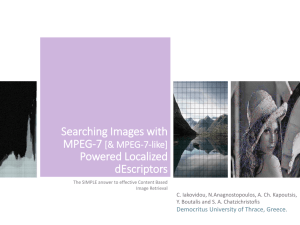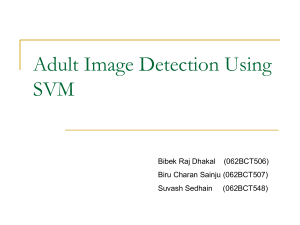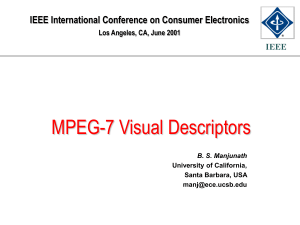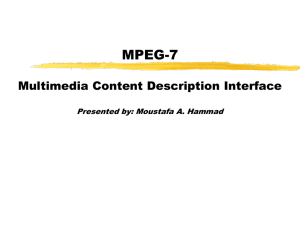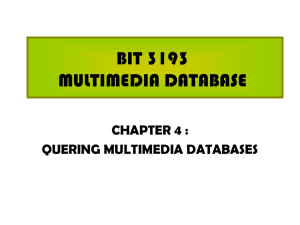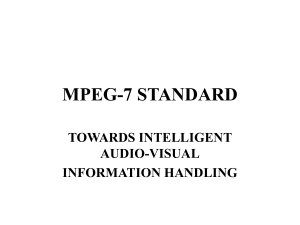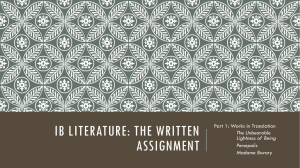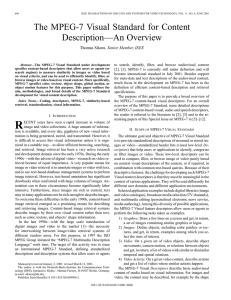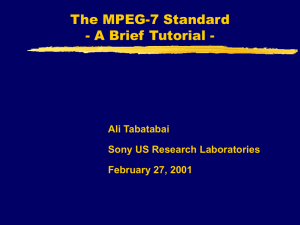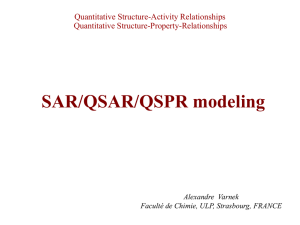Color layout descriptor
advertisement
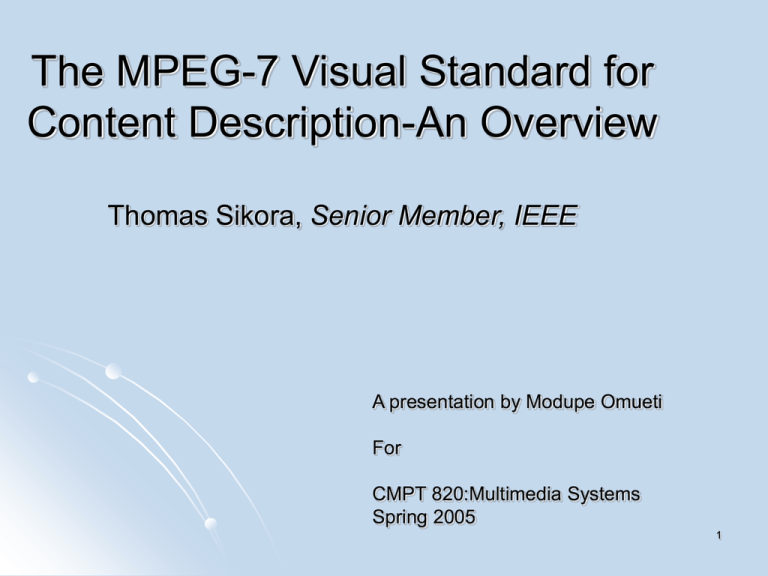
The MPEG-7 Visual Standard for Content Description-An Overview Thomas Sikora, Senior Member, IEEE A presentation by Modupe Omueti For CMPT 820:Multimedia Systems Spring 2005 1 Contents Introduction Scope Methodology Visual Descriptors Conclusion 2 Introduction Moving Pictures Expert Group MPEG-1 for interactive video (1992) MPEG-2 for digital television (1994) MPEG-4 for multimedia with emphasis on visual objects (1998 v1, 1999 v2) MPEG-7 for multimedia content description (2001) 3 Trends Initially few sources of audio, image and video Increase in volume of digitized audio, images and video Still images digital video 4 MPEG-7 Formally named Multimedia Content Description Interface Supports some degree of interpretation of the information’s meaning Interpretation can be passed on to or accessed by a device or computer code Not aimed at one application in particular 5 Scope Goals Elements Standardized descriptions Meaningful descriptions Description tools: visual decriptors and description schemes Description Definition Language System tools Figure 1: Scope of MPEG-7 Figure 2: MPEG-7 main elements 6 Normative part of MPEG-7 standard Figure 1: Scope of MPEG-7 7 Figure 2: MPEG-7 main elements 8 Applications Digital libraries (image catalogue, film) Broadcast media selection (TV channels) Investigation services (human characteristics recognition, forensics) Multimedia editing (personalized electronic news service) Figure 3: Abstract Representation 9 Figure 3: Abstract representation of possible applications using MPEG-7 10 Methodology Standard Development Specification for Technology Requirements Technology Request Proposal Evaluation Experimentation Model Definition Core Experiments 11 Visual Descriptors General visual descriptors Color, texture, shape, and motion features Domain specific Identification of human faces and face recognition 12 Visual Color Descriptors Color Spaces (HSV, HMMD) Supports above for normative purposes Also supports RGB, YCbCr color spaces Scalable color descriptor Figure 4 Global color Distribution of Images in color histograms HSV space, uniformly quantized into 255 bins Haar Transform used to encode histogram Histogram bin non-uniformly quantized color coefficients or histogram bin values for matching 13 Visual Color Descriptors Dominant color descriptor Color layout descriptor Spatial distribution of color in an arbitrarily shaped region Color structure descriptor Global + local spatial color distribution Colors clustered into a small no of representative colors representative color, %age, spatial coherency, variance HMMD, local color feature, sliding window Histogram on color appearance count Group of Frames/Group of Pictures SCD for a collection of similar images (frames) or video frames Average, median, intersection histograms of GoF or GoP 14 Figure 4: Three color images and their MPEG-7 histogram color distribution, depicted using a simplified color histogram. Based on the color distribution, the two left images would be recognized as more similar compared to the one on the right. 15 Visual Texture Descriptors Texture Features Visual patterns (homogenous or nonhomogenous) Multiple colors in images Multiple intensities in images Surface structural information Figure 5 16 Figure 5: Examples of grayscale images with different textures. Using the MPEG-7 Visual texture descriptors, the two images on the bottom would be rated of similar texture, while less similar in texture compared to the two images on the top. 17 Visual Texture Descriptors Homogenous texture descriptor Figure 6 Scale and orientation sensitive filters Mean and SD of frequency coefficients (RT-FT) Scale and rotation-invariant description and matching 2D Gabor functions for filtering feature channels Non homogenous texture descriptor (Edge Histogram) Spatial distribution of edges Division of image into 16 non overlapping blocks of equal size Five edge categories: vertical, horizontal, 45 , 135 , and non directional edge. Rotation-sensitive and rotation-invariant Non uniform quantization using 3 bits, descriptor size of 240 bits (16x5x3) 18 Figure 6: Frequency layout for MPEG-7 Homogenous Texture Descriptor frequency extraction. Energy and energy deviation values are extracted from this frequency division into 30 channels. 19 Visual Shape Descriptors Provides a powerful visual clue Invariant to scaling, rotation, and translation 2-D or 3-D in nature For 2-D there are two categories Contour based which uses only boundary information of objects Region-based which the entire shape region 20 Visual Shape Descriptors 3-D Shape Descriptor—Shape Spectrum Based on a shape spectrum concept Histogram of a shape index Measures local convexity of each local 3-D surface Histograms with 100 bins are used—each quantized by 12 bits. Region Based Shape Descriptor (Art) Figure 7 Uses all pixels constituting a shape within a frame Region-based moments invariant to transformations Coefficients of ART basis functions quantized 21 Figure 7: Examples of various shapes that can be indexed using MPEG-7 Region-Based Shape Descriptor. Images contained in either of the sets (a)–(d) would be rated similar and dissimilar to the ones in the remaining sets. For example, images in set (a) would be identified being similar and dissimilar to the ones in set (b), (c), or (d). 22 Types of Visual Shape Descriptors Contour based shape descriptor Figure 9 Curvature scale-space (CCS) Eccentricity and circularity values Robust to non-rigid motion partial occlusion of the shape and perspective transformations 2-D/3-D shape descriptor Representation of 3-D objects using multiple 2-D snapshots 23 Figure 8: Examples of shapes that can be indexed using MPEG-7 ContourBased Shape Descriptor. 24 Motion Descriptors for Video Motion Activity Descriptors Activity level and pace of motion in a scene Motion activity intensity descriptor SD of motion vector magnitude SDs quantized into five activity levels Optional Features motion direction spatial distribution of motion activity Temporal distribution of motion activity Camera Motion Descriptor Figure 9 Global motion parameters in time zoom activity translatory motion Motion similarity matching in particular time periods 25 Figure 9: Camera model for MPEG-7 Camera Motion Descriptor. Perspective projection to image plane p and camera motion parameters. The (virtual) camera is located in O. 26 Motion Descriptors for Video Warping Parameters Parametric motion descriptor Object description using 2-D parametric models translations, rotations, scaling and combination of them planar perspective models quadratic models Arbitrary objects, defined as regions (group of pixels) in the image over a specified time interval Global sprite or mosaic Motion Trajectory Description for independently moving objects Object displacement over time 27 Conclusion Identify, filter and browse images using visual content Specification to allow interoperability and flexibility Other MPEG-7 standards Storage, access and transmission of descriptors and descriptors schemes in system specification 28 29 Thank you 30
